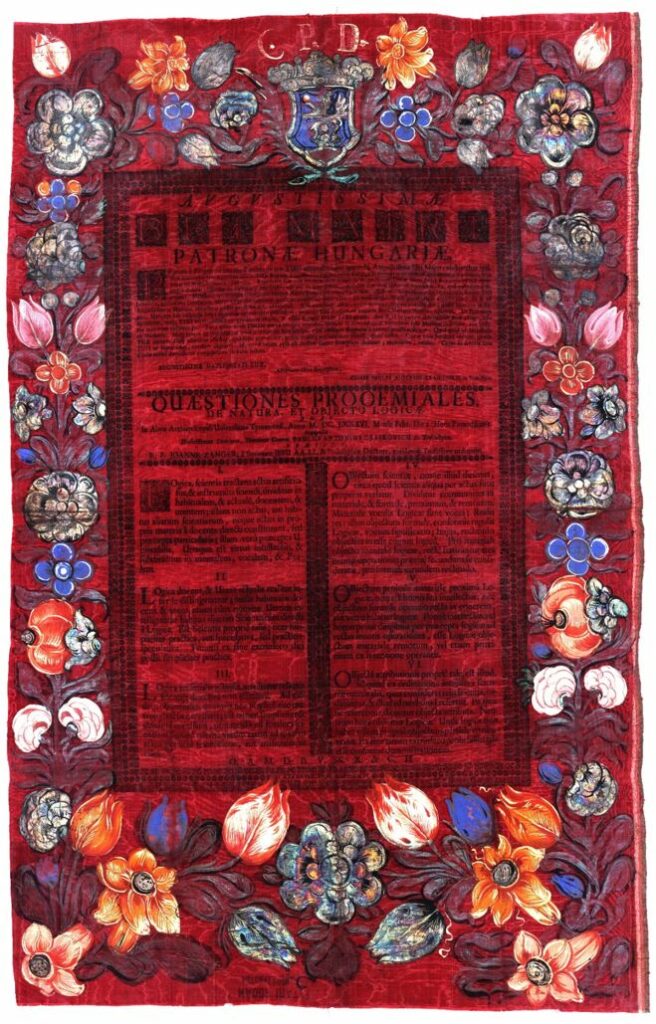The following document is the thesis paper of Pál Antal Draskovich of Trakostyán on silk, written in Latin, presented on the occasion of the 335th anniversary of its publication. This record will be on display at the first thematic exhibition of the European Digital Treasures project, entitled Construction of Europe – History, Memory and Myth of Europeanness over 1000 years. You can read more about the exhibitions here.

Reference code: HU-MNL-OL – P 125 – № 11961
The theses of the dissertation – which are defended in public debate at the universities – were usually published in the form of an ornate design on a single sheet. Theses printed on paper and parchment, decorated with artistic copper engraving were also common, but the copy presented here is made on silk. In terms of its theme, it includes examination topics collected from the subject of logics, from the first year of the Faculty of Arts at the University of Nagyszombat (today: Trnava, Slovakia).
At the University of Nagyszombat, founded in 1635, besides philosophy and the basic sciences such as logics, physics and metaphysics, students also studied theology and law. In line with the new educational principles introduced by the Jesuits, the emphasis in education was primarily on getting to know, to understand, and to clearly articulate these in writing. Thus, during the exams, the ability to debate played an extremely important role, in addition to the acquired knowledge. The exams were conducted in the framework of monthly public debates held on Saturday afternoons, which were led by the teacher of the given grade. According to the study regulations, the debates were to be attended by pre-defined contributors: the student, of course, as well as three defenders (defendentes) and three reviewers (oppugnantes). The content and topics (theses) of the discussion were also bound, which were posted in advance at the exam venue, on more solemn occasions they were also printed out and sent to the guests invited for the exam.
The thesis sheet of Pál Antal Draskovich is an especially decorative paper corresponding to the tastes of the Baroque era, which contains six exam topics explaining the subject and usefulness of the science of logic. The printed text on silk is surrounded by a hand-painted, richly colored floral ornament, which is adorned with the coat-of-arms of the Draskovich family.
Pál Antal Draskovich of Trakostyán (1668–1693) is a member of a Hungarian noble family of Croatian origin. His father, Judge royal Miklós Draskovich, held the second highest secular rank among the country’s nobles. However, he was executed in Vienna for taking part in the Wesselényi conspiracy, which aimed to overthrow the rule of the Habsburg House in Hungary and Croatia. Count Pál Antal’s mother was Krisztina Nádasdy – the daughter of Ferenc Nádasdy, one of the most powerful noble in the country and Júlia Anna Esterházy. This fact could have been a guarantee that, despite the public dragging of the head of the family, Pál Antal could receive a quality education.
Pál Antal Draskovich held a public debate on February 9, 1686 at the University of Nagyszombat. This thesis was probably made as a gift for the uncle of Pál Antal’s, palatine Pál Esterházy. Unfortunately, the life story of the young man with high hopes ended soon, and no major political career could take place since he died at the age of 25. His thesis sheet, on the other hand, is a beautiful example of the Baroque cultural and educational history. It will be seen as part of the third pillar of the exhibition Construction of Europe – History, Memory and Myth of Europeanness over 1000 years, which also deals with the creation and further traditionalization of the Christian knowledge base.
Dorottya Szabó, senior archivist, National Archives of Hungary
Anna Palcsó, public education officer, National Archives of Hungary
